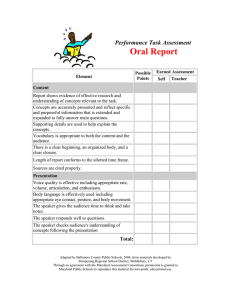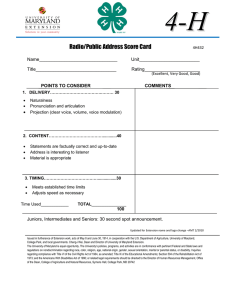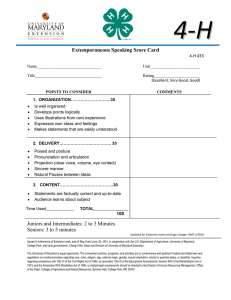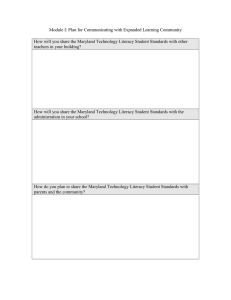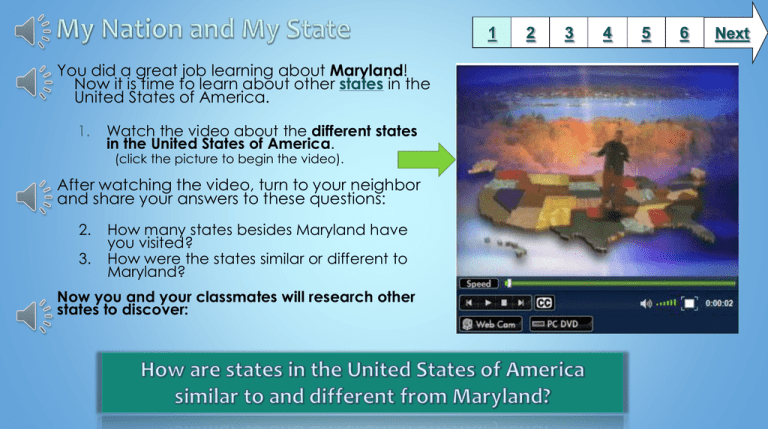
1
2
3
4
5
You did a great job learning about Maryland!
Now it is time to learn about other states in the
United States of America.
1.
Watch the video about the different states
in the United States of America.
(click the picture to begin the video).
After watching the video, turn to your neighbor
and share your answers to these questions:
2.
3.
How many states besides Maryland have
you visited?
How were the states similar or different to
Maryland?
Now you and your classmates will research other
states to discover:
Video Source: TeacherTube
6
Next
1
2
3
4
5
6
Next
You will choose one of the states shown below. You will gather information about the state by
clicking/tapping on the icons next to the state. You will need to use this information to complete the
state chart on Slide 3. You will look for things that are similar to and different from Maryland.
Key
Geography =
Economy =
Society /Culture =
Political Science =
1
You will use the resources on Slide 2 to
find out how the state you chose is
similar to and different from Maryland.
Click on the button below to open your state chart.
On your worksheet, follow these directions:
1. Circle (O) the characteristics that are similar to
Maryland.
2. Cross out (X) the characteristics that are
different from Maryland.
2
3
4
5
6
Next
1
2
3
4
5
6
To record your answers to the assessment, exit out of the PowerPoint slide show by using the esc button on the top
left of your keypad and click the down arrow button on your keypad to move to the next slide.
Geography
Economy
Society and Culture
Political Science
Next
1
Part A
2
3
4
5
6
The state I researched is
.
. It is similar to Maryland’s
Geography in many ways. For example,
Place the speaker symbol in the green
starburst once your recording is
complete.
Part B
The state I researched is
. It is different from Maryland’s
Geography in many ways. For example,
Place the speaker symbol in the green
starburst once your recording is
complete.
Need help recording your answer?
Click the speaker
Next
1
Part A
2
3
4
5
6
The state I researched is
. It is similar to Maryland’s
Economy in many ways. For example,
Place the speaker symbol in the green
starburst once your recording is
complete.
Part B
The state I researched is
. It is different from Maryland’s
Economy in many ways. For example,
Place the speaker symbol in the green
starburst once your recording is
complete.
Need help recording your answer?
Click the speaker
Next
1
Part A
2
3
4
5
6
The state I researched is
. It is similar to Maryland’s
Society and Culture in many ways. For example,
Place the speaker symbol in the green
starburst once your recording is
complete.
Part B
The state I researched is
. It is different from Maryland’s
Society and Culture in many ways. For example,
Place the speaker symbol in the green
starburst once your recording is
complete.
Need help recording your answer?
Click the speaker
Next
1
2
3
4
5
6
Part A The state I researched is
. It is similar to Maryland’s
Political Science in many ways. For example,
Place the speaker symbol in the green
starburst once your recording is
complete.
Part B The state I researched is
. It is different from Maryland’s
Political Science in many ways. For example,
Place the speaker symbol in the green
starburst once your recording is
complete.
Need help recording your answer?
Click the speaker
Next
1
2
3
4
5
6
Now you get to play a game based on the states
in the United States of America. Click on the
game you would like to play.
*Make sure that you save your PowerPoint! Ask your teacher
for directions.
Next
1
Grade 1 Social Studies
BCPS Curriculum / Maryland State Curriculum
Revising Grade 1 Social Studies: Unit 3 My Nation is a Community
Common Core State Standards
Reading: 1. Read closely to determine what the text says explicitly and to make logical inferences from it;
cite specific textual evidence when writing or speaking to support conclusions drawn from the text.
Writing: 7. Conduct short as well as more sustained research projects based on focused questions,
demonstrating understanding of the subject under investigation.
Standards for the 21st Century Learner
1.1.6 Read, view, and listen for information presented in any format (e.g. textual, visual, media, digital) in
order to make inferences and gather meaning.
2.1.3 Use strategies to draw conclusions from information and apply knowledge to curricular areas, realworld situations, and further investigations.
ISTE NETS - National Educational Technology Standards for Students
3. Research and Information Fluency: Students apply digital tools to gather, evaluate, and use information.
b. Locate, organize, analyze, evaluate, synthesize, and ethically use information from a variety of
sources and media.
4. Critical Thinking, Problem Solving, and Decision Making: Students use critical thinking skills to plan and
conduct research, manage projects, solve problems, and make informed decisions using appropriate
digital tools and resources. c. Collect and analyze data to identify solutions and/or make informed
decisions.
2
3
4
5
6
Time Frame: 2 class sessions
Differentiation strategies for this lesson:
Each slide has audio directions in addition to
typed directions
Each text resource has a read-aloud feature
that students can use.
Notes to the teacher:
This lesson is to be used at the end of Unit 3
to assess students and to assist teachers in
meeting their SLO goals.
Students must save the PowerPoint so
teacher can check for accuracy. See your
Library Media Specialist or STAT teacher for
assistance.
Alternative videos to use for Slide 1 can be
found here:
Safari Montage: 50 States
Marbles: Brain Beats Tour the States Music Video, Lyrics
Last updated: July 2014
Created by Andrew Murray,Social Studies Teacher and School Library Media Cohort intern and Jamie Higgins Shaull, Social Studies Department Chair
BCPS Slam Dunk Research Model, Copyright 2014, Baltimore County Public Schools, MD, all rights reserved. The models may be used for educational, non-profit school use only.
All other uses, transmissions, and duplications are prohibited unless permission is granted expressly. This lesson is based on Jamie McKenzie’s Slam Dunk Lesson module.

